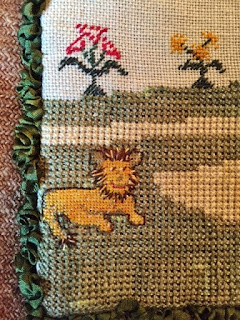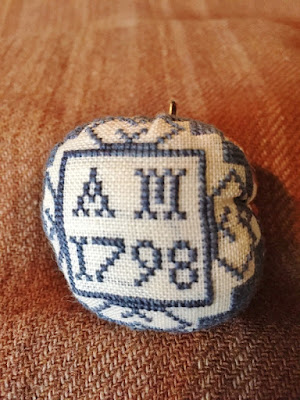This project required using materials and stitches that were very much outside my comfort zone, however, it was such fun and a joy to complete.
I used 18 count mono canvas, overdyed ribbon, DMC and metallic and pearl cotton threads.
Prickly Pine Stitching Etui, the Essamplaire here.
This design/kit is worked in Irish/Florentine stitch in a pattern known as Prickly Pine. The etui is based on 18th century American pocket books which were worked in a wool yarn; however, this one is silk thread for stitching on 35 count linen and silk fabric for the lining.
The inside has pockets for stitching tools, and a stitched needle book with wool felt pages. A stitched scissor sheath is included, a thread winder, and a 4"ruler made by their woodworker.
The top straight edge is personalized in cross stitch with my name and date.
My "Practice Stitch" needlebook. In 2012 our EGA Dayton Chapter did a program that included introducing a variety of stitches
Each month at the meeting, different stitches were introduced and we could practice these stitches prior to incorporating into our needlework piece. I decided that since I was going to be spending so much time "practicing" new stitches, I wanted a record and a permanent reminder.
Since I LOVE wallets, I chose a blue ticking and included a line of each stitch and to the right I jotted down the name of the stitch on the ticking as I completed the line. Prior to finishing the inside with partitions for my needlework tools, I cut off the list of stitches and keep it inside the needlebook for future reference of each stitch name.
************** Next - wallets ***************









































